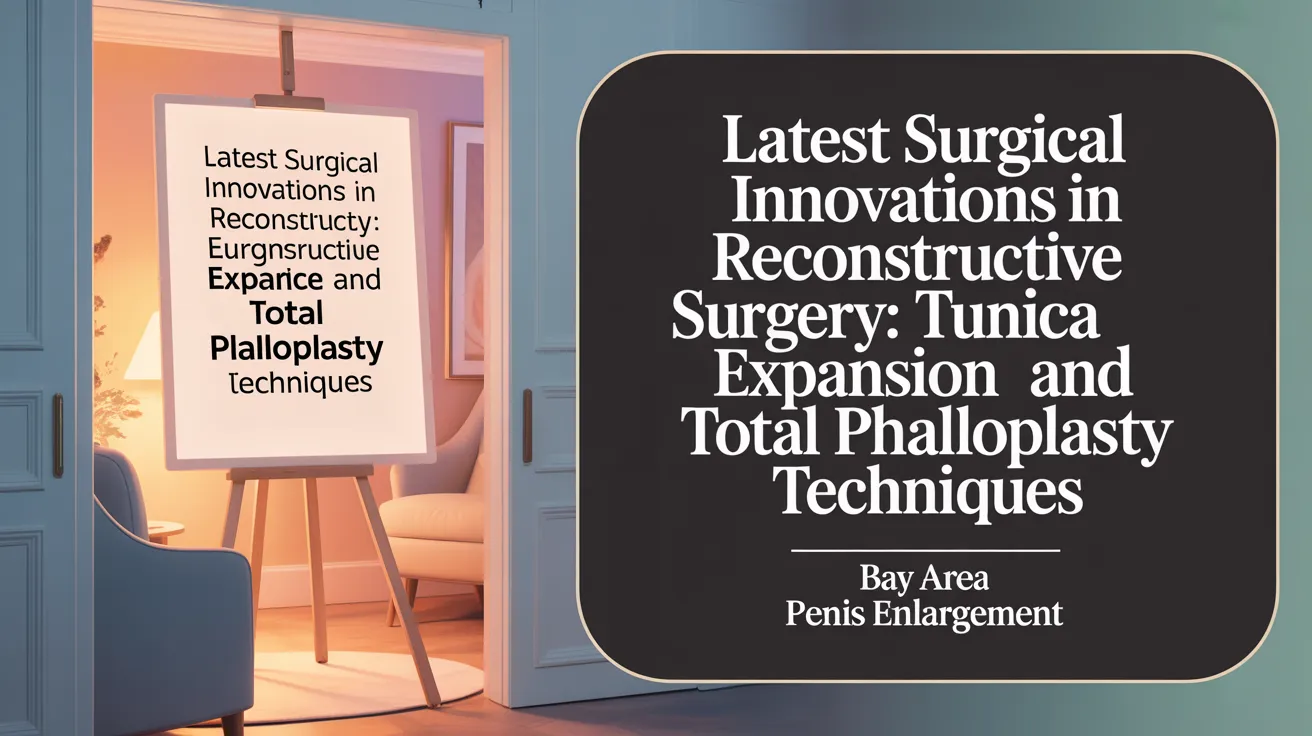Understanding Modern Approaches to Penile Enhancement
Penile enlargement surgery has evolved significantly with advancements in techniques designed to enhance both length and girth. While historically driven by functional reasons such as micropenis and buried penis correction, today’s surgical methods increasingly focus on aesthetic outcomes alongside safety and patient satisfaction. This article explores the latest surgical innovations, the spectrum of procedures available, and the critical considerations shaping effective penile augmentation, emphasizing the balance between maximum results and minimizing risks.
Overview of Penile Enlargement Surgery: Goals and Techniques

What are the primary goals and common techniques used in penile enlargement surgery?
Penile enlargement surgery aims to increase the length and/or girth of the penis. The goals may be functional, such as treating conditions like micropenis or buried penis, or cosmetic, related to concerns about penile size.
Techniques for lengthening versus girth enhancement
Lengthening procedures include suspensory ligament release, which detaches the ligament from the pubic bone to increase visible flaccid length by about 1.3 to 2.8 cm. More invasive lengthening methods like the sliding elongation technique and penile disassembly offer larger gains (3–4 cm) but carry higher risks. Total phalloplasty is reserved for severe cases such as traumatic loss or congenital anomalies.
Girth enhancement methods primarily involve soft tissue fillers (such as hyaluronic acid and polylactic acid), autologous fat grafting, dermal grafting, biodegradable scaffolds, and silicone implants like the FDA-approved Penuma®. The Penuma implant can increase girth by up to 56.7% and flaccid length by nearly 5 cm.
Common patient motivations and indications for surgery
Patients seek penile enlargement mainly for medical reasons including micropenis and buried penis, which affect urinary and sexual function. However, many pursue surgery for cosmetic concerns related to perceived penile inadequacy. Psychological factors can also motivate individuals with anatomically normal penises to seek enhancement. It is important for candidates to have realistic expectations and for surgeons to carefully evaluate suitability to optimize outcomes and minimize complications.
Innovative Lengthening Procedures: Suspensory Ligament Release and Sliding Techniques

How do suspensory ligament release and sliding elongation techniques differ in penile lengthening?
Suspensory ligament release is a surgical method that cuts the ligament anchoring the penis to the pubic bone. This procedure increases the visible flaccid length of the penis by approximately 1.3 to 2.8 centimeters but does not affect erect length. A notable advancement in this method is the 'cross-method,' which combines ligament release with cross-plasty skin techniques and a silicone spacer to prevent ligament reattachment. This refined approach improves cosmetic outcomes and results in better patient satisfaction compared to traditional techniques.
In contrast, the sliding elongation technique is a more complex and invasive procedure that involves making incisions in the tunica albuginea—the tough fibrous layer surrounding the corpora cavernosa—to physically lengthen the penile shaft. This method achieves greater length gains, typically between 3 to 4 centimeters, and increases the true corporal length of the penis, potentially affecting erect length as well. However, the increased invasiveness carries higher risks, including a notable rate of complications such as penile deformities and extended recovery times.
Surgical considerations and recovery protocols
Suspensory ligament release typically involves small incisions that can be hidden for better cosmetic results, with some surgeons making incisions along the scrotum or pubic hairline. Postoperative care is crucial to prevent reattachment of the ligament, often requiring the use of penile traction devices during recovery.
Sliding elongation procedures are more invasive, requiring careful surgical precision and hospital admission. Recovery involves managing swelling, possible pain, and longer healing periods, with patients often advised to abstain from sexual activity for up to six weeks or more.
Both procedures demand thorough patient evaluation and setting realistic expectations about length gains and risks. Choosing an experienced surgeon specialized in these techniques is essential for minimizing complications and optimizing outcomes.
Girth Enhancement Strategies: From Injectable Fillers to Implants

What are the current options for penile girth enhancement and their effectiveness?
Penile girth enhancement includes various methods ranging from injectable fillers to surgical implants aimed at increasing the circumference of the penis. Patients seeking girth augmentation have several options, each with differing effectiveness and safety profiles.
Injection-based approaches utilize soft tissue fillers such as hyaluronic acid (HA), polylactic acid (PLA), and polymethyl methacrylate (PMMA) microspheres. These fillers provide immediate volume increase, with effects lasting from several months to a few years depending on the substance used. HA and PLA are popular due to their biocompatibility and relatively low risk of adverse effects. Complications tend to be minor, including temporary swelling or bruising, making fillers a minimally invasive and reversible option (Dermal Fillers in Penis Enlargement; Fat grafting and dermal fat grafting techniques.
Autologous fat grafting involves harvesting fat from other areas of the patient's body and injecting it into the penile shaft. Although it provides a natural substance for girth enhancement, fat grafting carries the risk of significant fat resorption over time—reported to be as high as 20 to 80%—which can lead to uneven texture and require repeat procedures (Fat grafting for penis enlargement; Complications of fat injections).
For more durable and significant girth gains, the Penuma® implant offers a surgical solution. It is a soft, medical-grade silicone device approved by the FDA specifically for cosmetic penile enhancement. Implantation of Penuma® typically increases flaccid length by up to 4.9 cm and girth by approximately 40% to 57% (Penuma® device implantation and outcomes). This method has demonstrated high patient satisfaction and a relatively low complication rate, with the most common issues being minor seroma or capsular contracture in a small fraction of cases. The procedure is performed quickly, often as an outpatient surgery, and allows men to maintain normal erectile function (Penuma® implant procedure details).
In summary, soft tissue fillers provide a temporary, minimally invasive girth enhancement with mild risks, and fat grafting offers a natural but less predictable outcome. The Penuma® implant presents a reliable, FDA-approved implant option that delivers substantial and lasting girth and length improvements with acceptable safety for appropriately selected candidates.
Advanced Surgical Innovations: Tunica Expansion and Phalloplasty

What are the latest surgical innovations like tunica expansion and total phalloplasty used for?
Recent advances in penile enhancement surgery have introduced techniques such as tunica expansion and total phalloplasty, targeting significant length and girth augmentation or reconstruction in complex cases.
Tunica expansion is a novel approach involving small, staggered incisions along the tunica albuginea, the fibrous envelope surrounding the corpora cavernosa. This technique enables controlled tissue expansion, preserving or improving penile girth and length. A distinctive feature is the use of a single 3-centimeter scrotal incision rather than the traditional circumferential penile incision, reducing scarring and risk of complications like infection. The procedure typically lasts 2–3 hours with same-day discharge, aided by specialized anesthesia protocols that minimize pain without narcotics.
Total phalloplasty, on the other hand, is a more elaborate reconstructive surgery indicated primarily for conditions such as micropenis, severe trauma, or congenital absence of the penis. It often utilizes radial forearm free flap or similar tissue grafts to construct a neophallus. While flap survival rates exceed 96%, the surgery carries higher risks, potential complications, and longer recovery times, requiring skilled surgeons and holistic patient management.
Patient selection is pivotal. Tunica expansion suits men seeking cosmetic enlargement with preserved erectile function, whereas total phalloplasty is reserved for function-restorative or reconstructive cases. Both procedures demand comprehensive preoperative evaluation, tailored surgical planning, and careful postoperative care to achieve optimal functional and aesthetic outcomes.
Minimizing Complications: Surgical Techniques and Postoperative Care
How can complications be minimized in penile enlargement surgery?
Minimizing complications in penile enlargement surgery relies heavily on meticulous surgical technique and comprehensive postoperative care. Surgeons often hide incisions in less conspicuous areas, such as within the pubic hairline or the scrotum, to reduce visible scarring and improve cosmetic outcomes.
Innovative anesthesia protocols have been developed, such as the use of local nerve blocks that eliminate the need for narcotic pain medications. This approach has shown promising results, reducing postoperative pain and accelerating recovery. One advanced method involves a carefully controlled local anesthesia regimen that enables same-day discharge and low complication rates.
Preventing reattachment of ligaments after procedures like suspensory ligament release is critical. Surgeons use silicone spacers or specialized techniques to maintain the length gained and avoid regression.
Postoperative management includes gradual return to normal activities, careful monitoring for signs of hematoma or infection, and educating patients on realistic expectations and wound care requirements. Studies report infection rates below 1%—much better than the typical 1–5% national averages—demonstrating the effectiveness of modern protocols.
Overall, these strategies, combined with patient selection and experienced surgical teams, help improve satisfaction and reduce adverse events in penile augmentation surgeries.
Psychological and Functional Considerations in Penile Augmentation
What psychological and functional factors affect penile enlargement surgery decisions?
Penile augmentation surgery is often sought by men with perfectly normal penile size but who suffer from psychological conditions such as body dysmorphic disorder or small penis anxiety. These men perceive their penis as inadequate despite it being within average dimensions. On the other hand, true functional indications for surgery include micropenis and buried penis, which can significantly impair urination and sexual function.
Psychological factors influencing surgery demand
Many men request penile augmentation primarily for cosmetic reasons driven by dissatisfaction or anxiety about their size rather than actual dysfunction. This highlights the importance of psychological evaluation to identify these underlying issues. Counseling aims to clarify realistic surgical outcomes, as most length gains fall within 1 to 4 centimeters and girth enhancements vary. Addressing unrealistic expectations beforehand can reduce dissatisfaction post-surgery.
Functional indications versus cosmetic desires
Medical necessity arises mainly in congenital or acquired conditions such as micropenis (penis stretched length under 7.5 cm) or severely buried penis, where surgery improves quality of life by restoring normal urination and sexual function. Procedures for cosmetic purposes, while common, carry risks like infection, scarring, erectile dysfunction and may not achieve dramatic size changes.
Managing patient expectations and counseling
Effective patient counseling involves a comprehensive discussion about the potential benefits, risks, and realistic results. Including partners in preoperative counseling sessions enhances relationship support and satisfaction. Emphasizing that penile augmentation is not a solution for deeply rooted psychological concerns underscores the need for multidisciplinary care, including mental health professionals when appropriate.
Through thoughtful psychological and functional assessment, healthcare providers can better distinguish candidates who may benefit from surgery and ensure safer, more satisfactory outcomes.
State of Scientific Evidence and Need for Standardization
What is the current scientific evidence regarding penile enlargement surgery?
Penile enlargement surgery research is currently limited and challenging to interpret. Most published studies consist of case series involving small patient groups and diverse penile augmentation surgery techniques, leading to significant variation in data quality. Methodological differences make it difficult to compare results or draw firm conclusions about the long-term effectiveness and safety of these procedures.
There is a notable lack of standardized outcome measures and reporting protocols in the field. This inconsistency affects evaluation of key aspects such as gains in length or girth, complication rates, and patient satisfaction. Some procedures report high satisfaction rates, while others yield disappointing or mixed results as noted in complications in penile augmentation surgery and patient satisfaction in penile surgery.
Experts and systematic reviews stress the need for rigorous, long-term studies with standardized methodologies to improve future research in penile augmentation. Such research would allow objective assessment of benefits versus risks, facilitate evidence-based decision-making, and ultimately improve patient care. Until then, current evidence should be interpreted cautiously, and clinicians should emphasize realistic expectations and thorough informed consent as highlighted in the pros and cons of penile enhancement and Cleveland Clinic guidelines.
FDA Approval and Regulatory Status: The Penuma® Implant

What is the regulatory status and clinical performance of the Penuma® implant?
The Penuma® implant holds the distinction of being the only silicone penile implant approved by the U.S. Food and Drug Administration (FDA) specifically for cosmetic enhancement.
Clinically, it has demonstrated significant results, notably increasing flaccid penile length by an average of 4.9 cm. Additionally, patients experience an increase in penile girth ranging from approximately 39.9% to 56.7%, leading to noticeable improvements in both length and circumference.
The implant's safety profile is favorable, with complication rates reported to be around 4%. The most common complications include seroma (fluid accumulation) and capsular contracture. Importantly, removal rates of the device remain low, reinforcing its status as a durable and reliable option (Complications of Penuma® implantation.
FDA clearance is a crucial milestone, as it distinguishes Penuma® from many other penile augmentation products and procedures that lack such regulatory approval. This clearance ensures that the implant has undergone rigorous evaluation regarding safety and efficacy. It also provides patients with the confidence of receiving a device that meets standardized manufacturing and clinical care requirements, which is often lacking in unregulated treatments for penile enhancement (FDA approval of Penuma® device).
This regulatory status supports Penuma®'s position as a leading, scientifically validated choice for men seeking cosmetic penile enlargement, offering a benchmark for quality and patient outcomes in this field (Penile augmentation surgery techniques.
Non-Surgical and Adjunct Approaches in Penile Enlargement
What non-surgical options exist for penile enlargement and what are their limitations?
Non-surgical penile enlargement methods include traction devices, vacuum erection pumps, and injectable fillers. Traction devices require consistent use over several months and can produce modest increases in penile length. Vacuum pumps, primarily used to manage erectile dysfunction, can improve penile blood flow but have not been proven effective for actual enlargement and carry risks if overused.
Injectable options provide minimally invasive girth enhancement. Hyaluronic acid-based fillers offer immediate, reversible volume increases lasting 9 to 18 months, necessitating periodic retreatment. Biostimulant fillers stimulate natural collagen growth for longer-lasting results and feel more natural. However, these treatments can be costly and may cause temporary swelling or unevenness.
While non-surgical techniques are appealing due to less invasiveness, many lack strong scientific evidence for effectiveness and carry potential safety concerns if not applied correctly. Misuse of devices or unregulated supplements poses risks such as tissue injury or erectile dysfunction. Therefore, medical consultation is critical to evaluate suitability and avoid complications.
Future Directions in Penile Enhancement Surgery and Research
What emerging technologies and future directions are shaping penile enhancement surgery?
Penile enhancement surgery is evolving with promising advancements in tissue engineering in penile enhancement and biodegradable scaffolds in penile surgery. Biodegradable scaffolds seeded with a patient's own fibroblasts are being developed to safely augment penile girth, offering notable size increases while minimizing risks typically seen with traditional grafts.
Innovations in penile prosthetics are also underway. Electronic penile implants featuring features like electronically activated pumps and shape-memory alloys promise improved durability and more natural function, enhancing patient control and satisfaction. These next-generation devices may also integrate drug-eluting coatings to reduce infection risks.
Cutting-edge biomaterials, including 3D bio-printed customized implants, are emerging. These personalized solutions aim to match patient anatomy precisely, potentially improving both cosmetic and functional outcomes while lowering complication rates.
The future of penile enhancement is not only technological but also holistic. There is a growing emphasis on multidisciplinary and patient-centered care that combines urologic surgical expertise with psychological support and sexual health counseling. This comprehensive approach addresses the physical and mental well-being of patients, ultimately optimizing treatment satisfaction and reducing adverse effects.
Together, these advances promise safer, more effective, and tailored penile augmentation options that go beyond traditional surgical interventions to meet diverse patient needs.
Balancing Innovation and Caution in Penile Enlargement
Modern surgical techniques for penile enlargement have expanded the possibilities for enhancing both length and girth with improved safety profiles and patient outcomes. Innovations such as tunica expansion, sliding elongation, and advanced implants like the FDA-cleared Penuma device demonstrate significant progress. However, these procedures are accompanied by risks that demand skilled surgical execution, meticulous postoperative care, and thorough patient counseling. The current scientific evidence underscores the need for standardized studies to validate long-term effectiveness. Ultimately, the best results arise from individualized surgical plans that respect both physical and psychological factors, with ongoing research poised to further refine this evolving field.

